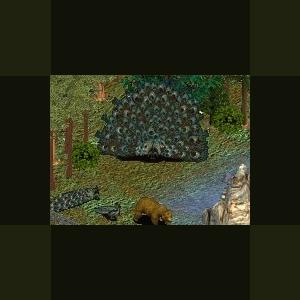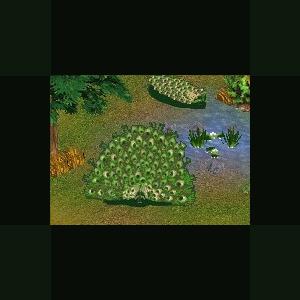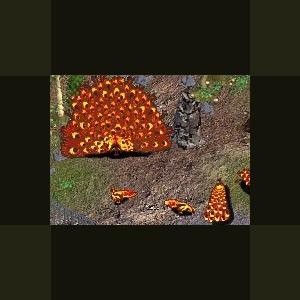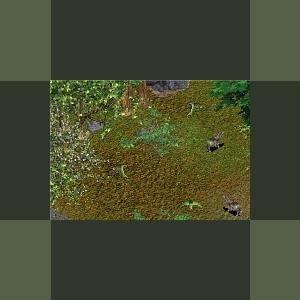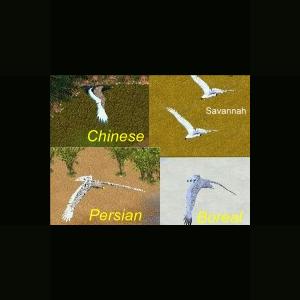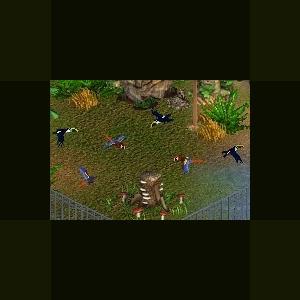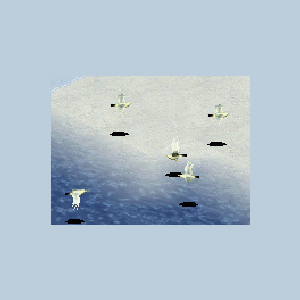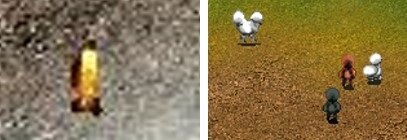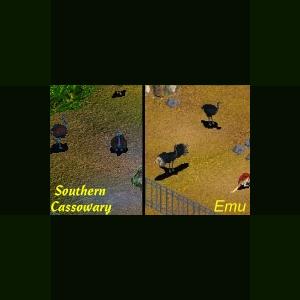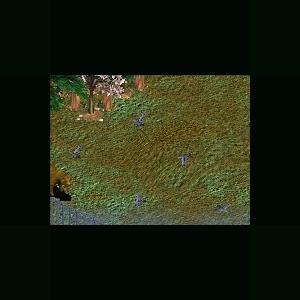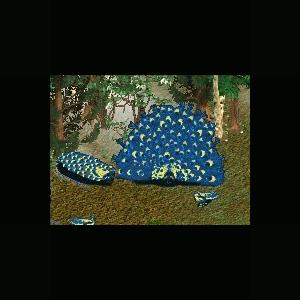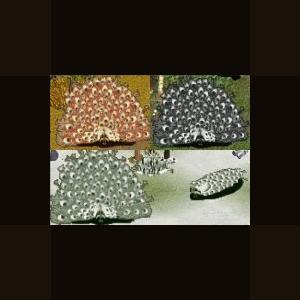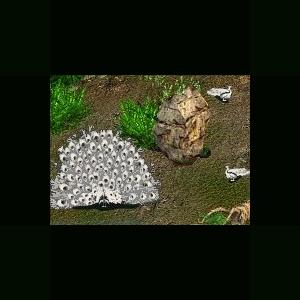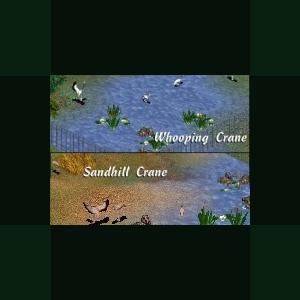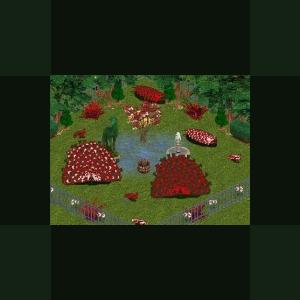Birds
Creatures on the wing
65 files
-
Ponderosa Peafowl by Genkicoll
By Guest
Ponderosa Peafowl
The Ponderosa Peafowl is a recently discovered subspecies of peafowl. Its late discovery comes from its excellent camouflage, small, widespread troops, and its remote location.
It is found deep in the mountains, within the thick forests that the Rockies offer. Most of these 'troops'are found in inpassible areas, riddled with steep cliffs, loose rock, and thick brush.
The male loses his long tail in the fall, only regrowing it in late winter/early spring; just in time to show off for the spring mating season. This naturally gives him maneuverability to escape from predators and get in and out of nooks and crannies where his long tail might hinder him.
The male keeps a rather consistant harem of 3 to 5 females. Hens usually nest in hollowed out logs or in large 'squirrel holes' found high in trees. Eggs are a mottled brown for camouflage.
Despite the carnivorous nature of grizzly bears, the Ponderosa Peafowl do no seem to mind sharing an exhibit with the enormous creatures.
100% compatible with the in-game grizzly.
*NOTE: This peafowl's favorite foliage, the ponderosa pine, was created by Brandi for this project. Thank you very much, Brandi!
Updated 2010-11-21
Just to save space with less in zip and smaller image.
Nothing new.
318 downloads
0 comments
Updated
-
Prairie Peafowl by Genkicoll
By Guest
Prairie Peafowl
Many avians are found throughout the prairie. But none are as magnificient as the Prairiefowl. Its almost neon green plumage catches the eye. The grass seems to part itself as the bird steps into shorter grass, as if letting royalty pass.
For all its glitz and glamour, the Prairiefowl is low on the foodchain. Coyotes, hawks, and wildcats find the bird rather tasty. It relies on its coloring to hide itself in the tall grass. When startled it will run at speeds up to 20mph, with short spurts of flight inbetween.
Its eating habits are also questionable. It does eat seeds, grasses, and insects; but it can also be found scratching through bison..droppings. Or snatching up an occasional snake or lizard for a little protein.
Peacocks often fight over harems, mostly while the peahens ignore them. The defeated may lose some feathers due to the fierceness of the competitions.
Hens lay their eggs in high, thick grass. Sisters and mothers may share nests, having several nests scattered about. This tactic ensure that if one nest is found, there will still be chicks from each female in another nest.
Chicks are ready to run as soon as they hatch.
NOTE: 100% compatible with the silkies made by Sundance and the Hereford cow made by Genkicoll.
Updated 2010-11-21
Just to save space with less in zip and smaller image.
Nothing new.
325 downloads
0 comments
Updated
-
Pyro Peafowl by Genkicoll
By Guest
The pyro peafowl is seldom seen in nature. Perhaps it is because they live in areas where volcanic eruptions and lava flows are common. These peafowl seem to thrive on the heat given off by volcanic activity, though they do need a nearby source of water. They require a highland habitat with some vegetation, and love geysers and volcanoes in their exhibit.
Compatible with other fiery animals, such as the volcanic unicorn, pyro zebra and fire horse.
Many thanks to Jens of ZTU for allowing us to recolor Willie T.'s original Indian Peafowl!
Updated 2010-11-21
Just to save space with less in zip and smaller image.
Nothing new.
300 downloads
0 comments
Updated
-
Red Crowned Parrot by Genkicoll
By Guest
The Red-crowned Amazon, (Amazona viridigenalis) also known as Red-crowned Parrot, Green-cheeked Amazon, or Mexican Red-headed Parrot, is an endangered Amazon parrot native to northeastern Mexico. The current native wild population of between 1,000 and 2,000 is decreasing. The main threats to its survival are the illegal export of trapped birds from Mexico to the United States and the destruction of habitat.
Description
Their appearance is generally green with the most notable features being a bright red forehead and crown, dark blue streaks behind the eyes, and light green cheeks.
Range
Their natural range is across the lowlands of northeastern Mexico. Feral birds have been introduced to urban communities of southern California and southern Florida. Birds in the Rio Grande Valley of Texas may be either feral or vagrants from Mexico.
Behaviour
They gather in large flocks being noisiest in the morning and evening. The characteristic screeching heard of these birds usually occurs when they travel in a large flock to a new feeding area. Diet consists of seeds, fruits, flowers and nectar. Red-crowned Amazons nest in tree cavities like most other parrots.
Aviculture
This parrot is often kept as a pet and can be very affectionate and playful when given the attention they need from their owners. Although some are excellent talkers, they are best at mimicking sounds.
References
* BirdLife International (2004). Amazona viridigenalis. 2006 IUCN Red List of Threatened Species. IUCN 2006. Retrieved on 11 May 2006. Database entry includes a range map, a brief justification of why this species is endangered, and the criteria used.
* "National Geographic" Field Guide to the Birds of North America ISBN 0-7922-6877-6
* Handbook of the Birds of the World Vol 4, Josep del Hoyo editor, ISBN 84-87334-22-9
* "National Audubon Society" The Sibley Guide to Birds, by David Allen Sibley, ISBN 0-679-45122-6
*100% compatible with the in-game Mexican Gray Wolf.
Updated 2010-11-21
Just to save space with less in zip and smaller image.
Nothing new.
385 downloads
Updated
-
Rocs by Ghirin
By Guest
All four of the great mythical birds by Ghirin in one zip file. Also includes a combined ztd for your convenience.
Chinese Roc:
The roc (also known as the rukh) is a mythical bird that resembles an enormous eagle. The roc is so large and strong that it is able to lift adult elephants off of the ground, then send them back to earth to their deaths. Tales of rocs have been described in both the writings of Marco Polo and the voyages of Sinbad.
The roc of China is the most colorful of the roc species.
Reference:
www.wikipedia.org
Boreal Roc:
The roc (also known as the rukh) is a mythical bird that resembles an enormous eagle. The roc is so large and strong that it is able to lift adult elephants off of the ground, then send them back to earth to their deaths. Tales of rocs have been described in both the writings of Marco Polo and the voyages of Sinbad.
The boreal roc lives in the artic regions and enjoys hunting musk ox and caribou.
Reference:
www.wikipedia.org
Persian Roc:
The roc (also known as the rukh) is a mythical bird that resembles an enormous eagle. The roc is so large and strong that it is able to lift adult elephants off of the ground, then send them back to earth to their deaths. Tales of rocs have been described in both the writings of Marco Polo and the voyages of Sinbad.
The Persian roc is the largest of the roc species and is found in southern Eurasia.
Reference:
www.wikipedia.org
Savannah Roc:
The roc (also known as the rukh) is a mythical bird that resembles an enormous eagle. The roc is so large and strong that it is able to lift adult elephants off of the ground, then send them back to earth to their deaths. Tales of rocs have been described in both the writings of Marco Polo and the voyages of Sinbad.
The savannah roc is the smallest of the rocs and can be seen soaring above the East African plains.
Reference:
www.wikipedia.org
Updated 2010-11-21
Just to save space with less in zip and smaller image.
Nothing new.
768 downloads
0 comments
Updated
-
Scarlet Maccaw and Yellow Ridge Toucan by Genkicoll
By Guest
Scarlet Macaw
The Scarlet Macaw (Ara macao) is a large, colorful Macaw. Some consider the Scarlet to be among the most beautiful birds in the world.
It is native to humid evergreen forests in the American tropics. Range extends from extreme south - eastern Mexico to Amazoniain Peru and Brazil, in lowlands up to 500 m (1,640 ft) (at least formerly) up to 1,000 m (3,281 ft). It has been widely extirpated by habitat destruction and capture for the pet trade. Formerly it ranged north to southern Tamaulipas. It can still be found on the island of Coiba. It is also the Honduran national bird.
Description
It is about 81 to 96 cm (32 to 36 inches) long, of which more than half is the pointed, graduated tail typical of all macaws. The average weight is about a kilogram (2 to 2.5 pounds). The plumage is mostly scarlet, but the rump and tail-covert feathers are light blue, the greater upperwing coverts are yellow, the upper sides of the flight feathers of the wings are dark blue as are the ends of the tail feathers, and the undersides of the wing and tail flight feathers are dark red with metallic gold iridescence. Some individuals may have green on the wings near the yellow band. Three subspecies present varying widths in their yellow wing band. There is bare white skin around the eye and from there to the bill. Tiny white feathers are contained on the face patch. The upper mandible is mostly pale horn in color and the lower is black. Sexes are alike; the only difference between ages is that young birds have dark eyes, and adults have light yellow eyes.
Scarlet Macaws make loud, low-pitched, throaty squawks, squeaks and screams designed to carry many miles.
Behavior
The Scarlet Macaw can live up to 75 years, although, a more typical lifespan is 30 to 50 years
Diet
Scarlet Macaws eat mostly fruits and seeds, including large, hard seeds. A typical sighting is of a single bird or a pair flying above the forest canopy, though in some areas flocks can be seen. They may gather at clay licks. They like apples, nuts, bananas, and fruits. They also feed on nectar and buds.
Breeding
The Scarlet Macaw lays two or three white eggs in a tree cavity. The female incubates the eggs for about 28 days, and the chicks fledge from the nest about 90 days after hatching. and leave their parents about a year later.
Distribution and habitat
Scarlet Macaws originate in the humid lowland subtropical rain forests, open woodlands, river edges, and savannas of Central and South America. The habitat of the Central American Scarlet Macaw runs through the extreme eastern and southern regions of Mexico and Panama, but also through Guatemala and Belize, while the South American population has an extensive range that covers the Amazon basin; extending to Peru east of the Andes, to Bolivia, and Paraguay. While generally infrequent on the mainland, great colonies of Scarlet Macaws can still be found on the islands of Coiba.
Before the Scarlet Macaw's decline in population, its distribution included much of Costa Rica. However, by the 1960s Scarlet Macaws had been decreasing in numbers due to a combination of factors, particularly hunting, poaching, and the destruction of habitat through deforestation. Further, the spraying of pesticides by companies cultivating and selling bananas for export played a significant role in decreasing Scarlet Macaw populations.
The combined factors stressed the population of Scarlet Macaws in Costa Rica, where they had previously occupied approximately 42,500 km² of the country's total national territory of 51,100 km², leaving viable populations in the early 1990s isolated to only two regions on the Pacific Coast of Costa Rica; the Carara Biological Reserve and Peninsula de Osa. By 1993 surveys had shown Scarlet macaws occupied only 20% (9,100 km²) of their historic range in Costa Rica.
The habitat of Scarlet Macaws is considered to be the greatest latitudinal range for any bird in the genus Ara, as the estimated maximum territorial range covers 6,700,000 km². Nevertheless, the Scarlet macaw’s habitat is fragmented, and colonies of the bird are mostly confined to tiny populations scattered throughout Central and South America. However, as they still occur in large numbers in some parts of their territory, where they are described as "common," the World Conservation Union evaluated the species in 2004 as "Least Concern".
Source: Wikipedia
Yellow-ridged Toucan
The Yellow-ridged Toucan (Ramphastos vitellinus culminatus) is a subspecies of the Channel-billed Toucan (Ramphastos vitellinus). It is a near-passerine bird which breeds in Trinidad and in tropical South America east of the Andes and as far south as southern Brazil. The western form of this bird, the Yellow-ridged Toucan, was previously considered to be a separate species, Ramphastos culminatus, but the two races readily interbreed.
This species is a resident breeder in moist lowland forest. The white eggs are laid in a high unlined tree cavity.
Like other toucans, the Channel-billed is brightly marked and has a huge bill. It is typically 48cm long with a 9-14cm bill. Sexes are similar. Both sexes are alike in appearance, and they are both active in raising the young. There is have a gestation period of 18 days, and the parents both incubate for 15 to 16 days. However, they can be impatient sitters, often leaving their eggs uncovered for hours at a time. Newborn toucans remain in the nest after hatching. They are blind and naked at birth, and their eyes open after about 3 weeks. They have short bills and specialized pads on their heels to protect them from the rough floor of the nest. The featheres do not begin to expand until they are nearly 4 weeks old. They're helpless and unable to leave the nest for about 8 weeks, dependent upon both parents to feed them. After this, the young can care for themselves. They begin to leave the nest after 40 to 50 days, depending on size.
The eastern nominate race has a black bill, upperparts and tail, and a red rump. The bare eyepatch and bill base are blue, the throat is white and the breast shows successive bands of yellow, whitish and red before reaching the black belly. The undertail is black apart from red undertail coverts.
The subspecies culminatus has a yellow top ridge to its black bill, and the throat and breast are white, with just a red band separating the latter from the black belly.
The Channel-billed Toucan is an arboreal fruit-eater, but will take insects and other small prey. The call is a croaking cree-op cree-op cree-op.
Source: Professor Paul's Nature Encyclopedia
NOTE: These birds are 100% compatible. Both will say that "There are more shelters than necessary in this exhibit", but they do not actually mind having the sunken ship in their exhibit... They actually like one there!
Updated 2010-11-21
Just to save space with less in zip and smaller image.
Nothing new.
905 downloads
0 comments
Updated
-
Sea Eagle by Jonathan
By Guest
The sea eagles-whose alternate name of erne is rarely used-are not closely related to golden eagles; their nearest relatives are probably certain types of vultures. Their bills are longer and heavier than those of the golden eagles, and (in adults) are bright yellow rather than grey, and their lower legs are unfeathered. They inhabit coastal regions and the vicinity of lakes and streams, and feed mainly but not exclusively on fish. The bald eagle, the national bird of the United States, is a member of this group. It ranges widely in North America from Alaska to Florida, with the largest individuals coming from the northern parts of the range. After the breeding season the northern birds migrate southward, whereas many Florida eagles wander northward. The name "bald", often thought to be a misnomer, does not imply a lack of feathers, but is derived from an obsolete word meaning marked with white, as in piebald. Young birds of this species lack the white head and tail of the adults, which take four to five years to attain. Compared to other eagles, the bald eagle is a relatively clumsy hunter and fisher, and for its prey relies mainly on dead or injured fish, or those that enter shallow water to spawn. It also steals fish from the osprey when the smaller bird has captured a live fish, harassing it in the air until the osprey drops the prey, whereupon the eagle snatches it.
The Eurasian counterpart of the bald eagle is the white-tailed sea eagle, which occasionally strays to Alaska. It is greyer than the bald eagle, and its head is pale but not white. The largest member of this group is Steller's sea eagle, which inhabits coastal areas of north-eastern Asia and occasionally visits the Aleutian and Pribilof islands of Alaska. It is a blackish eagle with a wedge-shaped white tail and (in adults) a large patch of white on the shoulders.
Updated 2010-11-21
Just to save space with less in zip and smaller image.
Nothing new.
481 downloads
0 comments
Updated
-
Silkie Chickens ~ Sunset Penguin by Sundance
By Savannahjan
Updated October 21, 2007:
Although the previous version of the Sunset Penguin worked in the original ZT, it would unexpectedly bash through fences in the expansion packs due to an error in the expansion packs. The above Sunset Penguin is now updated so that it no longer unexpectedly bashes through fences in the expansion packs. In addition, it has been optimized to use ingame sounds directly instead of having its own copies of the sounds, making the download much smaller. (Description of changes by Jay)
Silkies are a breed of chicken that have feathers like fur. Their laid-back personalities allow them to adapt to many different enviroments and make them excellent pets. This pack includes three different colors, Buff, Black, and White. They're compatible with several grassland animals, have fun figuring out which ones!
Updated 2010-11 to save space with less in zip.
93 downloads
0 comments
Submitted
-
Southern Cassowary and Emu by Genkicoll
By Guest
Australia's most spectacular bird would have to be the cassowary, up to two metres tall, covered in coarse black double stranded feathers, and with brilliant colors of red and blue on its neck and head. This elusive flightless bird is highly endangered and lives only in the Wet Tropics area of North Queensland and another patch of remote rainforest high up on the Cape York peninsula.
The cassowary (Casuarius casuarius johnsonii) has been wandering around this planet since before the super continent Gondwana broke up in to several continents, and they have relatives in several distant continents. They belong to a family of birds called ratites and are related to the Emu, the Ostrich, the Kiwi (though there is a dramatic difference in size) and the South American Rhea - a little known bird that resembles a small emu and runs around plains in Patagonia. They are also related to the now extinct Moas of New Zealand and the Elephant Bird of Madagascar. In New Guinea there are two other species of cassowary too but in Australia the only species is the Southern Cassowary.
Cassowaries (genus Casuarius) are frugivorous; fallen fruit and fruit on low branches is the mainstay of their diet. They also eat fungi, insects, frogs, spiders, snakes and other small animals, even dead ones and roadkills. They live for about 40-50 years. They are the second-largest bird in Australia and the third-largest remaining bird in the world (the ostrich and emu are larger). "Cassowary" originates from the Malay name kesuari.
The birds grow to 1.5 - 1.8 m tall, though the females are larger and can reach 2 m and they weigh about 60 kilograms, but the heaviest recorded was 83kg. They have a bony casque on the head that is used to batter through underbrush, this is made of keratin, the same material as our nails and hair. The casque is also used for headbutting and some people believe it is used to receive the very low frequency humming noise that they can make.
Usually cassowaries are very shy but when they feel threatened or want to protect their young they can lash out dangerously with their powerful legs and jump and kick with both legs at once. Their three-toed feet have sharp claws; the dagger-like middle claw is 12 cm long. Cassowaries are very capable of killing dogs by disemboweling them and have injured people, though only one death has been recorded, more on this on cassowary attacks. They can run up to 50 km/h and jump up to 1.5 m. They are also good swimmers.
They don't have much of a family life, they are solitary birds but females will cruise around the forest mating with several males during the breeding season from May to November. Courtship is initiated by the male when a female enters his territory. The smaller sized male must approach the larger female with caution because if she is not in the mood she is capable of seriously injuring him. The male begins courtship by circling around the female and making a low rumbling sound. When she has laid her eggs, three to eight, measuring about 90 by 140 mm and pale green-blue in color, in a shallow scrape in the ground in which the male has placed leaves and grass, she moves on again to repeat the process with another male. It is the male's duty to incubate the eggs for about fifty days and also to care for the chicks for another year or so. The chicks are striped until they are about 6-9 months old and become a glossy black colour when they are about 3 years old. By that time, the skin on the neck and head begins to turn color, and the casque begins to develop. Cassowaries are capable of breeding when they are three years old.
Source: http://www.rainfores...n/cassowary.htm
The Emu is a large native Australian bird that cannot fly. It is similar in appearance to the Ostrich, which also cannot fly; in fact, the Emu is in the same family as the African Ostrich and the South American Rhea. They have grey-brown feathers, a pale-blue neck and face, long powerful legs and three toes (ostrich's only have two!). Emus are the world's third largest living bird. Only the Ostrich and Cassowary are slightly larger.
Habitat
Emus live in small mobs and feast on a simple diet of grasses, seeds, fruit, flowers and small insects. They drink water regularly, at least once a day in winter and twice a day in summer and sometimes drink up to four gallons a day. Therefore they can usually be found within walking distance of water. When drinking they can take up to 70 mouthfuls of water and they lift their head after each one. They prefer flat country where there is enough rain each year to fill the waterholes, but will move into desert areas after the rain.
Emus have survived over 80 million years in the deserts, forests and plains of Australia. There used to be three species of Emu, but two became extinct after European settlers came to Australia.
Emus can be found in most areas of Australia, except for the East coast.
An average adult male Emu is between 1.5-2 metres tall, and weighs between 35 and 50 kilograms. The female Emu is even larger but they have a life span of only six years. Because the Emu has strong, long legs, they are a very fast running bird and can run up to 60 kilometres an hour over short distances, while their stride is about 3 metres long. They also use their legs to kick at animals or humans that try to attack.
Breeding
Emus mate when they are about eighteen months old. The female lays between five and fifteen eggs that weigh up to one kilogram each. She will usually lay them on trampled grass or in a hollow in the ground. She leaves the eggs in the care of the male Emu, while she often finds another mate and lays another set of eggs.
Meanwhile male Emu builds up the nest, which can be up to two metres wide, from leaves, grass and bark. The eggs are dark green in colour and are sometimes collected by people as display pieces. Animals such as foxes, dingoes, eagles and even lizards will also seek out the eggs as a food source.
The male incubates the eggs for a period of seven to eight weeks, turning the eggs over once a day, and does not leave the nest during this time. If the female approaches the eggs, the male chases her away. Female Emus have been known to kill their chicks.
When the eggs hatch, the male Emu cares for the striped chicks for up to six months. The chicks can walk within twenty-four hours of being hatched. The female Emu does not care for the eggs nor does she care for the chicks.
Population
Emus moved farther away in the country when the settlers built towns and farms, and when foxes and cats were introduced into Australia they attacked and killed many emus. In the 1930's in Western Australia teams of army machine-gunners killed many Emus in an effort to maintain the farmers' valuable wheat crops. Despite this, Emu numbers managed to thrive, and there is currently a healthy Emu population in Australia, with more emus now than there were 200 years ago. Farmers today are allowed to breed and raise Emus for meat, leather, and oil. Emu oil is used in the treatment of muscle and joint pains, such as arthritis, and also in cosmetics.
Interesting Facts
The Emu, along with the Kangaroo, is featured on the Australian Coat Of Arms – these 2 animals were chosen for the honour because they can't travel backwards and can only move forwards. The Coat of Arms also appears on the Australian 50 cent coin.
Source: http://library.think.../birds/emu.html
This animal is 100% compatible with the in-game kangaroo.
Updated 2010-11-21
Just to save space with less in zip and smaller image.
Nothing new.
700 downloads
0 comments
Updated
-
Stellar Jay by Genkicoll
By Guest
The Steller's Jay (Cyanocitta stelleri) is a jay native to western North America, closely related to the Blue Jay found in the rest of the continent, but with a black head and upper body. It is also known as the Long-crested Jay, the Mountain Jay, and the Pine Jay. It is the only crested jay west of the Rocky Mountains.
The Steller's Jay shows a great deal of regional variation throughout its range. Blackish-brown-headed birds from the north gradually become bluer-headed farther south. The Steller's Jay has a more slender bill and longer legs than the Blue Jay and has a much more pronounced crest. The head is blackish-brown with light blue streaks on the forehead. This dark colouring gives way from the shoulders and lower breast to silvery blue. The primaries and tail are a rich blue with darker barring.
It occurs over virtually the whole of the western side of North America from Alaska in the north to Central America in the far south and east to south-western Texas, completely replacing the Blue Jay in most of those areas. Some hybridization with the Blue Jay in Colorado has been reported. The Steller's Jay lives in coniferous and mixed woodland, but not in completely dense forest, and requires open space. It typically lives in flocks of greater than 10 individuals.
This bird is named after the German naturalist Georg Wilhelm Steller who discovered them in 1741 (Evans 1986).
Habitat
The Steller's Jay primarily lives in coniferous forests but can be found in many forested areas. They can be found in low to moderate elevations as high as the tree line, but rarely go that high. Steller's Jays are common in residential and agricultural areas with nearby forests. The range is primarily west of the Rocky Mountains, reaching as far south as Central America and as far north as Alaska.
Diet
As they are omnivores, their diet is about two-thirds plant matter and one third animal matter. Food is gathered from both the ground and from trees. The Steller's Jay's diet consists of a wide range of seeds, nuts, berries and other fruit. Many types of invertebrates, eggs, small rodents, and nestlings are also eaten. There are some accounts of them eating small reptiles, both snakes and lizards. Acorns and conifer seeds are staples during the non-breeding season; these are often cached in the ground or in trees for later consumption. They exploit human-provided food sources, frequently scavenging picnics and camp sites.
Reproduction and Nesting
The nest is usually in a conifer but is sometimes built in a hollow in a tree. Similar in construction to the Blue Jay's nest, it tends to be a bit larger (25 cm to 43 cm), using a number of natural materials or scavenged trash, often mixed with mud. Between two and six eggs are laid during breeding season. The eggs are oval in shape with a somewhat glossy surface. The background colour of the egg shell tends to be pale variations of greenish-blue with brown- or olive-coloured speckles. The clutch is usually incubated entirely by the female for 17 to 18 days.
Vocalizations
Like all jays, its calls are numerous and variable. Notably, its alarm call is a harsh nasal "wah". It also imitates the cry of the Red-tailed Hawk and Red-shouldered Hawk, which has the effect of causing other birds to vacate feeding areas at the Steller's Jay's approach. Some calls are sex-specific; females produce a rattling sound while males make a high-pitched "gleep".
Source: Wikipedia
Updated 2010-11-21
Just to save space with less in zip and smaller image.
Nothing new.
334 downloads
0 comments
Updated
-
Swedish Proud Peafowl by Genkicoll
By Guest
Swedish Proud Peafowl
You might ask why these peafowl are so proud. Can they be more proud than your average peafowl? Perhaps so, but the reason why these particular peafowl carry the name of "proud" is that they display the colors of the Swedish flag.
The Swedish Peafowl's home is generally a forested area that contains a water source and abundant plant life. The winter snow seems to have little effect on these lovely birds, for they thrive in their natural habitat.
NOTE: 100% compatible with the Nordic Moose by Jordan
Updated 2010-11-21
Just to save space with less in zip and smaller image.
Nothing new.
305 downloads
Updated
-
Tundra Savann and Asian Peafowl by Genki
By Guest
Three habitat-themed peafowl for your zoos: Arctic - the Tundra Peafowl; Savannah - the White-eyed Kenyan Peafowl; and Highlands - the Asian Shadowfowl. The Savannah and Highlands peafowl are both compatible with in-game animals.
Tundra Peafowl
Nicknamed the mint, or ice mint peacock, this interesting fellow is found on the borderlands tundra. Much like many tundra inhabitants, this bird shrugs of its boring brown coloring for a white shroud in the winter.
Unlike the other inhabitants, the male doesn't wear the usual all white or brown and white coloring. Instead it dons feathers of iridescent green and white, perhaps to give the illusion of grass peeking up through snow.
The Tundra peafowl has a very dense layer of down feathers for warmth. This gives the bird a beefier look compared to other peafowl.
The temperament of the bird is slightly more aggressive than the normal array of peafowl. This probably stems from the fact that the bird has to deal with more land predators, there aren't many trees to roost in on the wide, open tundra.
They've been known to bully the ptarmigan for nesting spots and food.
White-eyed Kenyan Peafowl
An African sunset, the grasses painted golden, the sky a mixture of red, orange, and yellow. The earth itself has taken on an amber cast.
This gorgeous specimen seems to have taken that image and painted it onto its tail.
The bird itself is found throughout the savannah of Africa, though it was first described in Kenya.
The first bird was reportedly found in a snare and was thought to either be a sunbleached released bird, or a subadult. Occasional sightings of 'peacock-like' birds were reported. It wasn't until a male was caught by a naturalist that anyone took notice.
Kenyan Peafowl eat fruit, seeds, insects, the occasional lizard. During the day they search in shorter grasses for their favorites. They are usually found within reach of trees of height. Should they be startled, they take immediate flight.
At night they roost, usually in thorn acacias. The ants and thorns don't seem to be a deterrent.
Mating season is a time of high mortality rate for the males. Nothing says 'come eat me' like pick-up lines, dancing, and displaying.
Females will hunt out ostrich nesting sites, nesting close by. Nothing deters the big predators like having an huge cousin as a (unknowing) bodyguard.
*100% compatible with the in-game ostrich. NOTE: The screenshot shows 10 filled squares of foliage, though the ostrich says it only likes three. You'll find that the exhibit suitability for the ostrich is higher this way. As shown, the ostrich's suitability is 95%, with a 100% suitability for the peafowl.
Asian Shadow Peafowl aka Asian Shadowfowl
The proper name for this coloration is melonistic peafowl with the 'white-eyed' gene at work, however, few call it that. Panda, shadow, black, night, or leopard are but a few nicknames for it. Birds of this shade prefers to stick to the shade, hence their most commonly-known name, Shadowfowl. Some of these peafowl even go as far as coming out only at evening and at dusk.
This striking peafowl variation lives in the highlands side-by-side with the gentle giant panda, and even with Asian black bears. They need plenty of elevation, and will enjoy having a shelter in their exhibit, even though the do not require one.
NOTE: 100% compatible with the in-game Giant Panda, but will also happily share an exhibit with the Asian Black Bear.
Updated 2010-11-21
Just to save space with less in zip and smaller image.
Nothing new.
493 downloads
0 comments
Updated
-
White Indian Peafowl by Genkicoll
By Guest
The Indian Peafowl is also known as the Blue Peafowl or Blue Peacock. Peacock refers to the male of the species, whereas peahen refers to the female.
There are three species of peafowl in the world, the Malaysian Peafowl, of southeast Asia and Maylay Peninsula, the Congo Peafowl of the African Rainforests and the Indian Peafowl. The white peafowl are not albino, just a color variation of the Indian Peafowl. These birds have blue eyes. White peachicks start out yellow with white wings.
Wild Indian Peafowl are primarily found in the Rainforests of India, Bangladesh, and Sri Lanka. Due to its adaptability, they have been domesticated for over 2000 years, and have spread around the world with the help of human civilization. Escaped domestic peafowl have established wild populations on every continent except Antarctica.
The primary habitat of the Blue Peafowl includes water, rock and thick rainforest. They live in large groups and are very social animals, and are rarely bothered by human presence. They are just as at home in a city park as they are in the dense forest. Guests to your zoo will be thrilled to see this beautiful bird proudly displaying its plumage!
Many thanks to Jens for allowing us to recolor Willie T's original Indian Peafowl! Fully compatible with the Indian Peafowl in the ZTU Catalog section of our database
Updated 2010-11-21
Just to save space with less in zip and smaller image.
Nothing new.
676 downloads
0 comments
Updated
-
Whooping and Sandhill Crane by Genkicoll
By Guest
Whooping Crane
The whooping cranes' breeding habitat is the muskeg of the taiga; the only known remaining nesting location is Whooping Crane Summer Range in Wood Buffalo National Park in Alberta, Canada and the surrounding area. With the recent Whooping Crane Eastern Partnership Reintroduction Project, whooping cranes nested naturally for the first time in 100 years in the Necedah National Wildlife Refuge in Central Wisconsin, USA. They nest on the ground, usually on a raised area in a marsh. The female lays 1 or 2 eggs, usually in late-April to mid-May. The blotchy, olive-colored eggs average 2½ inches in breadth and 4 inches in length (60 by 100 mm), and weigh about 6.7 oz (190 g). The incubation period is 29–35 days. Both parents brood the young, although the female is more likely to directly tend to the young. Usually no more than one young bird survives in a season. The parents often feed the young for 6–8 months after birth and the terminus of the offspring-parent relationship occurs after about 1 year.
Breeding populations winter along the Gulf coast of Texas, USA near Corpus Christi on the Aransas National Wildlife Refuge, Matagorda Island, Isla San Jose, and portions of the Lamar Peninsula and Welder Point, which is on the east side of San Antonio Bay.
Up to 75% of the nations population pass through Salt Plains National Wildlife Refuge in Oklahoma annually.
The whooping crane is endangered mainly as a result of habitat loss. At one time, the range for these birds extended throughout midwestern North America. In 1941, the wild population consisted of 21 birds. Since then, the population has increased somewhat, largely due to conservation efforts. As of April 2007 there were about 340 whooping cranes living in the wild, and another 145 living in captivity. The whooping crane is still one of the rarest birds in North America. The United States Fish and Wildlife Service confirmed that 266 whooping cranes made the migration to Aransas National Wildlife Refuge in 2007.
These birds forage while walking in shallow water or in fields, sometimes probing with their bills. They are omnivorous and slightly more inclined to animal material than most other cranes. In their Texas wintering grounds, this species feeds on various crustaceans, mollusks, fish (such as eel), berries, small reptiles and aquatic plants. Potential foods of breeding birds in summer include frogs, small rodents, smaller birds, fish, aquatic insects, crayfish, clams, snails, aquatic tubers and, berries. Waste grain, including wheat and barley, is an important food for migratory birds such as the whooping crane.
Sandhill Crane
The Sandhill Crane (Grus canadensis) is a large crane of North America and extreme northeastern Siberia. The common name of this bird references habitat like that at the Platte River, on the edge of Nebraska's Sandhills in the American midwest. This is the most important stopover area for the Lesser Sandhill Crane, Grus (canadensis) canadensis, with up to 450,000 of these birds migrating through annually.
Adults are gray overall; during breeding, the plumage is usually much worn and stained, particularly in the migratory populations, and looks nearly ochre. The sandhill crane has a red forehead, white cheeks and a long dark pointed bill. Its long dark legs trail behind in flight, and the long neck is kept straight in flight. Immature birds have reddish brown upperparts and gray underparts. The sexes look alike. Size varies among the different subspecies. This crane frequently gives a loud trumpeting call that suggests a French-style "r" rolled in the throat, and they can be heard from a long distance.
Mated pairs of cranes engage in "unison calling." The cranes stand close together, calling in a synchronized and complex duet. The female makes two calls for every single call of the male.
The only other large grayish-bodied bird of North America is the Great Blue Heron. This heron is of similar dimensions to the Sandhill Crane and is sometimes mistakenly called a crane, even though it is very different in plumage details and build. Like other herons, it flies with its neck tucked toward the body.
The sandhill crane's large wingspan, which is 6-8 feet when fully grown, makes this a very skilled soaring bird similar in style to hawks and eagles. Utilizing thermals to obtain lift, they can stay aloft for many hours, requiring only occasional flapping of their wings and consequently expending little energy. With migratory flocks containing hundreds of birds, they can create clear outlines of the normally invisible rising columns of air (thermals) that they ride.
Although it is rare, some Sandhill Cranes have been spotted devouring their young. If the mated pair recognizes a weakness in a young bird, they will eat it.[citation needed]
The Sandhill Crane flies south for the winter. In their wintering areas they form flocks of over 10,000 birds. One place to observe this is at Bosque del Apache National Wildlife Refuge, 100 miles south of Albuquerque, New Mexico. Just before Thanksgiving every year there is a Sandhill Crane Festival there. Use a search engine and get the information and go to this natural wonder.
Source: Wikipedia
*Included are both the separate ztds and a combined ztd. If you are using the combined ztd, you will not need to have the individual ztds in your game.
Updated 2010-11-21
Just to save space with less in zip and smaller image.
Nothing new.
672 downloads
Updated
-
Wonderland Peafowl by Genkicoll
By Guest
The Queen of Hearts red and white peafowl and King of Spades red and black peafowl for your Wonderland or colorful zoos.
Queen of Hearts Peafowl
A gift from a king, a glorious fowl, but the queen did not want it. Such a 'drab' bird in her halls of pearl and ruby? Never!
The court was scandalized. Surely it could not be good to deny a gift from a king! Trouble would be afoot.
The clever rabbit had a plan, a plan whispered in a card-gardeners ear. The next day the bird of green and blue was a proper rose and ivory.
The Queen of Hearts was delighted, acquiring more of these glamorous birds.
Paintbrushes and buckets at ready, no birds of emerald and saphire ever appear in the gardens.
These peafowl have become so accustomed to their surroundings that they have come to enjoy eccentricities as much as their namesake. Red and white items, hedges and odd items seem to be their preference. They do not even seem to mind the odd croquet players that pass through, nor the intermittent screams of, "Off with her head!!"
The Queen so prizes her magnificently-colored peafowl that she has never beheaded a single one!
King of Spades Peafowl
Black and red, red and white,
The queen's wardrobe varied little
And her garden followed suit
The gardeners found themselves a plight
Red and white clashed it did
They'd have to color those birds again
Paint and brushes at the ready
They rushed to do as the queen bid
Birds of red and black were made,
Quickly dubbed the Kings of Spade.
*NOTE: These peafowl will enjoy having just about anything in their exhibit. Please remember that your guests can't see past in-game hedges! Shown with some of Genkicoll's Fantasy Foliage.
Many thanks to Jens of ZTU for allowing us to recolor Willie T's original peafowl, and to Sundance for coming up with such interesting descriptions!
UPDATED July 18, 2009 to fix the description error on the King of Spades Peafowl.
Updated 2010-11-21
Just to save space with less in zip and smaller image.
Nothing new.
323 downloads
0 comments
Updated

